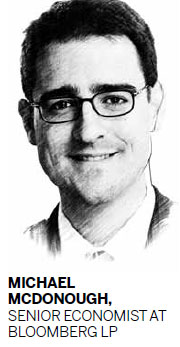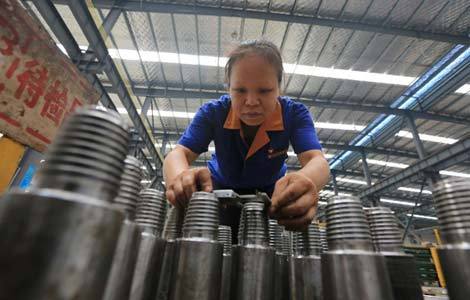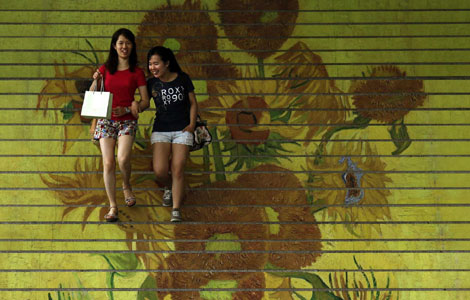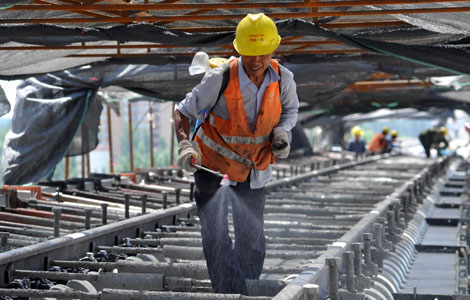Slowdown to continue
Updated: 2013-07-16 07:13
By He Wei in Shanghai (China Daily)
|
||||||||


The Chinese government is signaling unprecedented tolerance for slower growth in the second half of 2013, as officials strive to swap fast, low-quality growth for more sustainable expansion, a senior economist has said.
An adjusted growth target of 7 percent may emerge in 2014, setting the country on a temporary turbulent journey toward a more-balanced economy, according to Michael McDonough, senior economist at Bloomberg LP.
But for the next six months, the government may still accelerate investment projects and cut interest rates, among other efforts to defend a 7.5 percent GDP growth target, he noted.
Since this year, China's macroeconomic data have consistently come in below analysts' forecasts, leading to a series of growth downgrades, he said. For instance, the government's 2013 GDP goal is 7.5 percent, well below January's consensus forecast of 8.1 percent.
On Monday, the National Bureau of Statistics said that GDP growth slowed to 7.5 percent in April to June, the ninth quarter in the past 10 that expansion has weakened.
It is interesting to note that historically, the government's target has acted more as a floor than a legitimate target. But this year that is very likely to change, McDonough said.
"They won't set next year's target below 7 percent, but I do think a general trend is going to be a continued slowdown. Slower growth will be a good thing, though it will inevitably cause some short-term pain. But in order to rebalance, you need to lessen the reliance on investment," he said.
The 4 trillion yuan ($651 billion) stimulus package enacted following the 2008 financial crisis, while bolstering growth, essentially led to a surge in credit expansion and generated extensive industrial overcapacity, which McDonough said was responsible for much of the current slowdown in China.
The overcapacity especially obvious in the manufacturing sector, where the Producer Price Index, a main gauge of inflation at the wholesale level, has dropped for 16 consecutive months, indicating tepid domestic demand.
Another case in point is the surging amount of social financing after the 2008 input, where an increasing portion of these loans, which targeted lower-valued projects, may struggle to stay afloat in an environment of slowing growth.
Annual new yuan loan-issuance between 2008 and 2012 was on average more than 140 percent above the 2007 level.
McDonough noticed a change in the response to the slowdown compared with five years ago.
"While the government still has room to increase investment in certain infrastructure projects that may boost urbanization, a goal the new leadership has highly valued, officials are showing a restrained response and instead, attempting to encourage more private-sector involvement," he noted.
He believed that the urbanization-driven infrastructure investment is going to be a value-added, smart use of money to bring people to cities and have a decent return in the long run, where the stimulus program only resulted in industry bubbles.
While these types of investment may accelerate in the second half of the year, the aim will probably be to achieve the government's official target, rather than what investors may perceive as market-friendly 8 percent growth, he added.
"Allowing slower growth implies China's economy may be in store for some pain before the situation improves. But it also signifies that officials are increasingly willing to act to rebalance the economy, placing it on a sounder footing in the longer term," he said.
While officials have publicly recognized that China's economy needs to lessen its dependence on investment, there has yet to be tangible success on that front.
Investment's share of GDP rocketed to 48.3 percent in 2011, while household consumption shrank to just 35.4 percent, compared with 50 percent in 1989.
McDonough said that the rising contribution of investment has meant that slower growth is almost a "necessity" if China is to shift toward consumption and the private sector as a major growth engine.
"If we use the 2011 data (which is the most recent available), just to offset a 1 percent decline in China's gross capital formation, household consumption would need to increase by almost 1.5 percent due to its smaller base level," he said.
But the development model has been proven effective. McDonough referred to the "Great Moderation" period in the 1980s, when former US Federal Reserve chairman Paul Volcker increased the federal funds rate to 20 percent to combat extremely high inflation and slow growth. While this pushed the US economy into a deep recession, it succeeded in lowering inflation, leading to a period of reduced volatility and strong growth.
With China's own transition already seemingly under way, near-term risks still exist, though they can probably be manageable. Apart from the outsized credit growth, a slower expansion may be disruptive for China's financial sector.
The recent surge of interbank lending rates has placed pressure on the People's Bank of China to stabilize the sector.
To maintain the 7.5 percent annual growth rate, reforms are likely to accelerate into year-end, McDonough has forecast.
He predicted that officials may soon move closer to interest-rate liberalization by lifting the ceiling on deposit rates, which paves the way for opening the capital account in the medium term.
hewei@chinadaily.com.cn
(China Daily 07/16/2013 page16)

 Obama urges restraint amid protests
Obama urges restraint amid protests
 Putin wants Snowden to go, but asylum not ruled out
Putin wants Snowden to go, but asylum not ruled out
 Apple to probe death of Chinese using charging iPhone
Apple to probe death of Chinese using charging iPhone
 Investment falters as industrial activity flags
Investment falters as industrial activity flags
 Rape victim's mother wins appeal
Rape victim's mother wins appeal
 Reproduction of 'Sunflowers' displayed in HK
Reproduction of 'Sunflowers' displayed in HK
 Land Rover enthusiasts tour the world
Land Rover enthusiasts tour the world
 US star sprinter fails drug test
US star sprinter fails drug test
Most Viewed
Editor's Picks

|

|

|

|

|

|
Today's Top News
China calls for new talks on Iran nuclear issue
Global warming may largely raises sea level
Putin wants Snowden to go, asylum not ruled out
Top foreign study destinations for Chinese
Trailblazer reaches out to inmates on death row
Air crash payouts could differ
Cabinet promises more funds for smaller firms
Capital prison tests therapy on inmates
US Weekly

|

|






